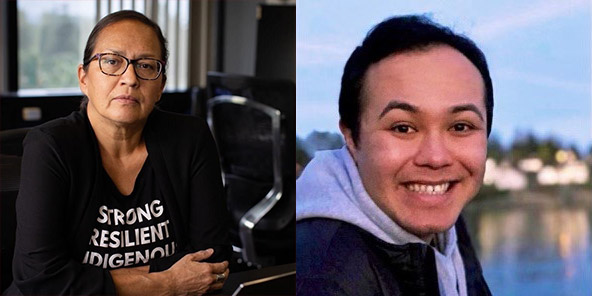
A message from Dr. Nel Wieman, Acting Deputy Chief Medical Officer; and Adam Gauthier, Child & Youth Care Coordinator, Mental Health & Wellness Team
During COVID-19, many have found it difficult to stay connected due to the need for physical distancing. Despite these challenges, First Nations youth have led the way in offering new and fresh ways for us to stay connected online and enhance our mental wellness. Whether it is offering tips to stay active, get rooted in culture and build our skills, or providing peer-to-peer advice for how to access online counselling and wellness services, the wisdom and knowledge held by youth is more important than ever, and we are listening.
One of the ways Indigenous youth are supporting each other and sharing their culture is through social media apps like TikTok and Snapchat. In October, the FNHA's Youth Advisory Committee launched its Youth and COVID-19 Wellness campaign on several social media platforms and has lots of engagement. The first two months of the campaign saw over 45,000 shares online and 600+ clicks through to the campaign website. At a time when connecting in-person is difficult or advised against, we can all learn a lot from Indigenous youth and we can work together to ensure our online spaces remain safe, empowering and sacred.
Holding a Sacred Space for Youth Online
Even though we are physically distancing, when we connect online, we are still united in spirit. Online spaces can be sacred spaces too. When we join together online, we can keep the principles and protocol associated with a sacred fire in-mind to make sure we are connecting in a good way. A sacred fire can be seen as a way to bond individuals with the spiritual world and nurture their identity. The principles we have learned and bring into online spaces are reciprocity, respect, responsibility, and relationship.
These four teachings all represent something we carry and show with integrity. With reciprocity, we feed the fire with wood and other materials (e.g., tobacco) while we surround it to keep ourselves warm and engaged. Respect is given to the individuals, land, and life that is a part of the environment. Responsibility is to self, including having good intentions and working towards them. And relationship is for balancing spiritual, emotional, physical and mental wellness.
We often use fire in teachings when we gather, perform protocol and/or ceremony, and honour respected ones. This space is always sacred and focuses on the well-being of who we are as individuals, families, and communities. There is no judgment in this area, and with common ground it helps provide medicine for our souls.
A sacred fire is inviting for all to experience and be a part of, especially for our present and future generations. When we center a sacred fire, we keep everyone warm and build connection through reflective thoughts and positive energy. The longer we keep the fire lit and feed it with wrap-around care, the more our Indigenous children and youth can share their minds and engage with others by being together in a space which allows that.
As we continue to find new ways to stay connected online, let's continue to learn from and listen to youth – they know this area well. And let's keep the principles and practices of the sacred fire in mind when we engage online.
At the same time, we need to acknowledge that while youth are often well-versed and adept in the online world, they don't necessarily know how to be safe there, or how to create resilient and healing spaces. This can be accomplished through co-learning and co-creating.
Ideally, our common online spaces should remain spaces of resiliency, purpose and healing. It is up to all of us—young and old—to keep the sacred fire burning.

